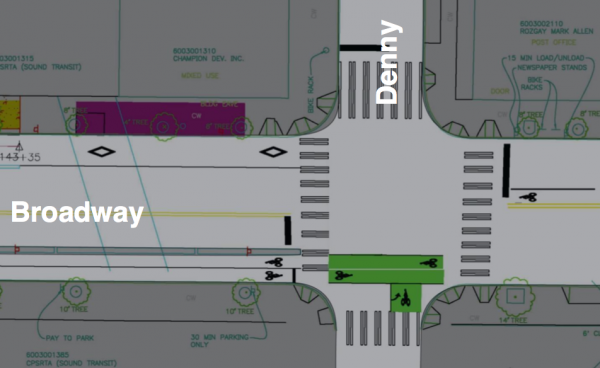 Planners presented more specifics about the proposed Broadway cycle track, which has now been dubbed the “Broadway Bikeway.” The project is part of the First Hill Streetcar, which will connect Pioneer Square and King Street Station to the under-construction Capitol Hill Link light rail station at Broadway and Denny via Jackson, Yesler and Broadway.
Planners presented more specifics about the proposed Broadway cycle track, which has now been dubbed the “Broadway Bikeway.” The project is part of the First Hill Streetcar, which will connect Pioneer Square and King Street Station to the under-construction Capitol Hill Link light rail station at Broadway and Denny via Jackson, Yesler and Broadway.
The First Hill Streetcar is Seattle’s chance to do modern streetcars right. The city’s most recent streetcar, the South Lake Union Streetcar, massively neglected the needs of bicyclists by turning Westlake Ave into one of the most dangerous streets in the city to ride a bike. Understandably, many people in Seattle who ride bikes approach new streetcar projects with caution.
However, the city’s plan for a two-way separated bike lane on Broadway (which pays for itself, no less) has garnered a lot of excitement. A modern bikeway project of this scale is new territory for the city, and similar projects have proven very successful in cities from Vancouver and Portland to New York and, of course, in Europe.
So how will the city safely handle turning maneuvers that cross the dangerous streetcar tracks? How will cyclists on the bikeway be protected from turning cars? How will pedestrians and cyclists interact, particularly at transit stops? Plans presented to the City Council this morning reveal some more specific ideas for solutions.
Bike boxes for turning
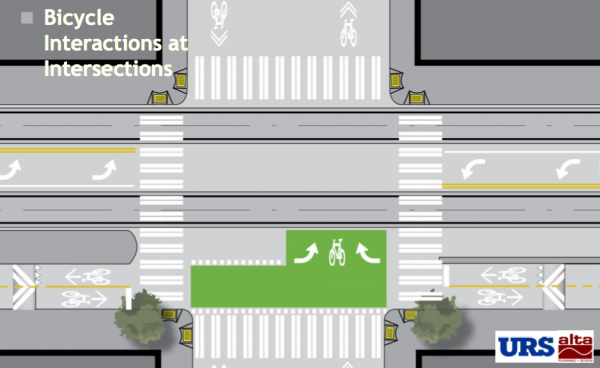 Bike boxes will be vital in making the Broadway Bikeway work. They will also increase pedestrian safety by having cars stop further back from the intersection and by restricting dangerous right turns on red. Cyclists wanting to make a turn that would cross the tracks will queue up in a bike box out of the path of the bikeway, the crosswalk and Broadway traffic. When the light changes, cyclists will simply go straight across the intersection, thus crossing the cracks at a safe 90 degree angle and staying in a safe, visible road position. The city has begun experimenting with bike boxes of different forms (7th and Dearborn, 12th and Madison, and 12th and Pine).
Bike boxes will be vital in making the Broadway Bikeway work. They will also increase pedestrian safety by having cars stop further back from the intersection and by restricting dangerous right turns on red. Cyclists wanting to make a turn that would cross the tracks will queue up in a bike box out of the path of the bikeway, the crosswalk and Broadway traffic. When the light changes, cyclists will simply go straight across the intersection, thus crossing the cracks at a safe 90 degree angle and staying in a safe, visible road position. The city has begun experimenting with bike boxes of different forms (7th and Dearborn, 12th and Madison, and 12th and Pine).
Pedestrian crossings at transit stops
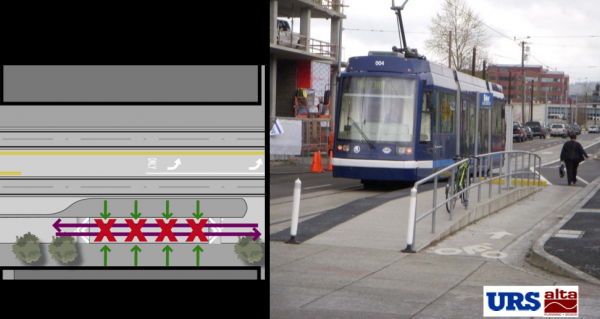 People on bicycles will be told to yield to pedestrians at transit platform crossings, but one idea to reduce conflicts is to put up a barrier so that people on foot all cross at a single point. This reduces the area where conflicts could occur. Signs will alert pedestrians of the bikeway, and bikes will be alerted of crossing pedestrians.
People on bicycles will be told to yield to pedestrians at transit platform crossings, but one idea to reduce conflicts is to put up a barrier so that people on foot all cross at a single point. This reduces the area where conflicts could occur. Signs will alert pedestrians of the bikeway, and bikes will be alerted of crossing pedestrians.
Driveways and turning motor vehicles
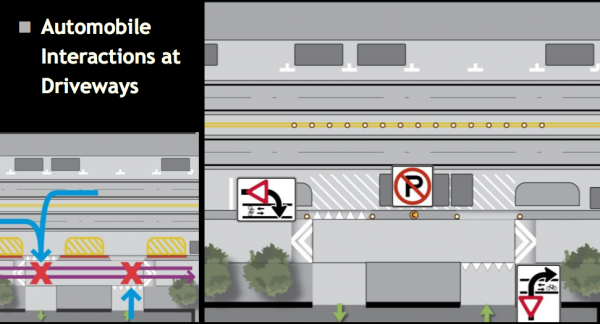 One of the most important things that can be done to reduce conflicts at driveways is to keep sightlines clear. This means reduced parking near crossings. Signage, paint treatments and other visual aids can also help alert drivers to be aware of cyclist traveling both directions on the bikeway.
One of the most important things that can be done to reduce conflicts at driveways is to keep sightlines clear. This means reduced parking near crossings. Signage, paint treatments and other visual aids can also help alert drivers to be aware of cyclist traveling both directions on the bikeway.
Separated lanes on Yesler
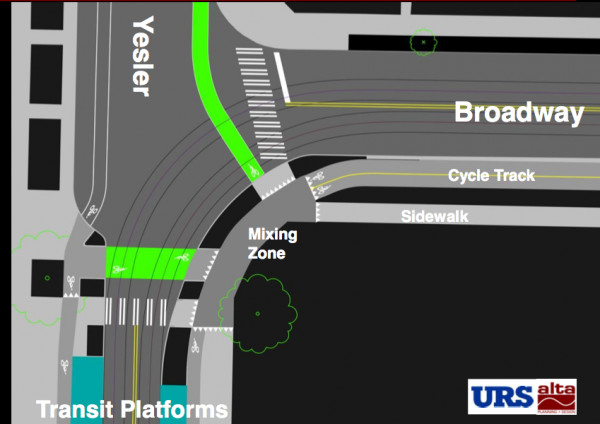 It appears planners are looking at splitting the bikeway into two one-way separated bike lanes on Yesler. There will be a brief “mixing zone” where pedestrians and cyclists traveling in all directions come together.
It appears planners are looking at splitting the bikeway into two one-way separated bike lanes on Yesler. There will be a brief “mixing zone” where pedestrians and cyclists traveling in all directions come together.
The update did not include details for the Yesler and Jackson sections of the project. I would love to see separated bike lanes on Jackson, as well. I’ve argued before that safe, modern bicycle facilities on Jackson have immense potential for making many city bicycle trips safer and more appealing. Considering that Jackson carries several thousand fewer cars per day than Broadway (13,900 vs 15,800), this seems like a great opportunity to extend this bikeway all the way to Pioneer Square.
The slideshow presented to the City Council:
Watch the presentation (bikeway discussion starts around 79:00):








Comments
2 responses to “Planners present more details for Broadway Bikeway”
Thanks for this article. I’ve been concerned about how turns across Broadway would be handled. It looks like they’re on the way to a workable solution.
I super excited about this project. If only they could find the money to extend this past Denny up to Aloha as has been discussed by the City.
The combination of the new Link station, streetcar and redesigned Broadway will fundamentally transform this neighborhood.